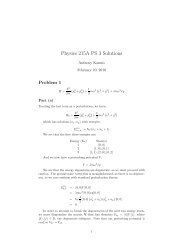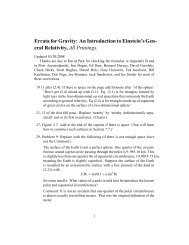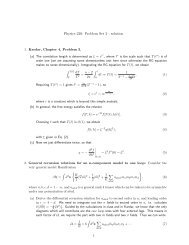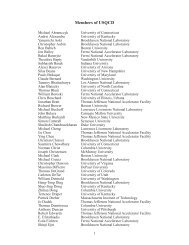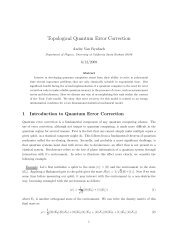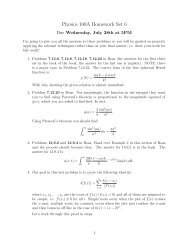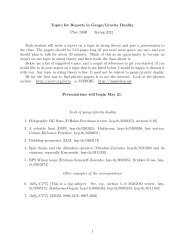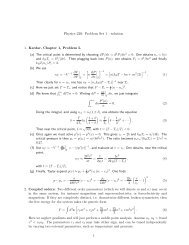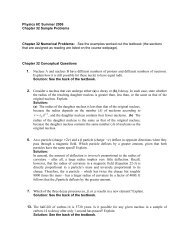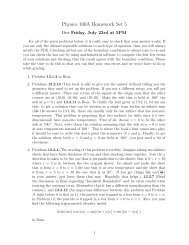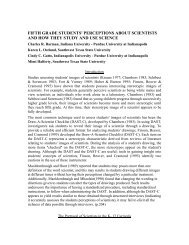Nuclear Spectroscopy
Nuclear Spectroscopy
Nuclear Spectroscopy
You also want an ePaper? Increase the reach of your titles
YUMPU automatically turns print PDFs into web optimized ePapers that Google loves.
DATA ANALYSIS<br />
Record the photopeak energies and net counts for all<br />
significant peaks that you observe in your spectra. Do<br />
you observe the gammas from the daughters of either<br />
radium isotope? Do you see evidence for radium in<br />
both the branch and the leaves? Why or why not? Can<br />
you suggest other biological or geological sources<br />
that concentrate calcium and possibly radium?<br />
Biological uptake of iodine, cesium, barium, and<br />
strontium radioisotopes from fission products can be<br />
health-threatening to many forms of life, including<br />
human, depending upon the total exposure from the<br />
isotope.<br />
Exercise 14.3<br />
Gamma Spectra from Liquids<br />
Liquids need not mean just water, but for the sampling<br />
suggested here it does. Whatever is in the air can<br />
also become included in the rain and collected from<br />
rainwater. Water filtered from rivers and streams<br />
includes not only the rain’s contributions, but the<br />
radioisotopes provided by land runoff and factory or<br />
sewer discharges. Standard filter paper will remove<br />
some of the insoluble material of diameters greater<br />
than 0.1 µm.<br />
For rainwater and snow you may expect to see radionuclides<br />
from cosmic-ray production, radon decay<br />
products ( 222 Rn and 220 Rn), and some nuclear fission<br />
decays, especially 137 Cs. Recent volcanic activity may<br />
add thorium-series, uranium-series, and potassium<br />
radioisotopes. Water from a sewage treatment facility<br />
or from a river downstream from such a plant may<br />
have measurable levels of 99m Tc or 131 I, if there are<br />
hospitals using these isotopes and discharging them<br />
through the treatment plant you are observing. Fertilizer<br />
runoff from agricultural lands can give an<br />
increased yield of 40 K.<br />
OBJECTIVE<br />
Observe the radioactive decay of isotopes filtered<br />
from rainwater, melted snow, or other effluents. Fresh<br />
rainwater and snow will be sources similar to atmospheric<br />
samples. Water from sewage treatment facilities<br />
will provide sources of medical and nuclear industrial<br />
wastes.<br />
SUPPLIES<br />
•coffee can or other large cylinder with detachable<br />
lid<br />
•filter paper (e.g. #41 Whatman)<br />
•permission to acquire water samples from private<br />
property<br />
SUGGESTED EXPERIMENTAL PROCEDURES<br />
1. Cover one end of your container with a perforated<br />
cap that holds your filter. About 10-15% of<br />
the cap area should be perforated.<br />
2. Run 200-1,000 liters of water or melted snow<br />
through your filter. Rainwater collection is enhanced<br />
by placing the filter can under a downspout.<br />
3. Start the MCA and check your calibration.<br />
4. Dry, cut, and stack the filter paper to fit neatly in<br />
your sample holder. Line your holder with plastic<br />
wrap to prevent its contamination. Acquire a<br />
spectrum for about 1 hour.<br />
5. Measure a background spectrum.<br />
6. Repeat your spectral measurement three days<br />
later. Record the spectrum for two hours.<br />
DATA ANALYSIS<br />
Blending of gamma lines can sometimes be resolved<br />
by taking advantage of the different half-lives of the<br />
gamma emitters. Your ability to measure the halflives<br />
will depend upon the span of time you measure<br />
and your ability to reduce the background radiation.<br />
Short half-lives (< a few hours) can be measured, but<br />
it requires a short sample collection time, and immediate<br />
counting of the sample.<br />
Isotope concentrations in water samples (Bq/l or<br />
pCi/l) provide important environmental measures<br />
of waste discharge or runoff. What concentrations<br />
did you find? How good are your measurements, and<br />
what measurement errors may limit their accuracy?<br />
Assume that your filtering is 100% efficient.<br />
47



